-
Rectilinear propagation
When light travels through a homogeneous medium, it travels in a straight line. This is known as rectilinear propagation.
-
Reflection
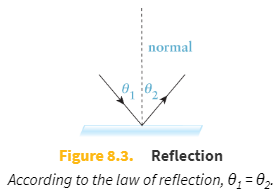
Reflection is the rebounding of incident light waves at the boundary of a medium.
-
Law of reflection
θ1 = θ2
θ1 is the incident angle
θ2 is the reflected angle
Both are measured from the normal
-
Normal
The normal is a line drawn perpendicular to the boundary of a medium.
-
In general, images created by a mirror can be either _____ or _____.
real
virtual
-
Real image
An image is said to be real if the light actually converges at the position of the image.
-
Virtual image
An image is virtual if the light only appears to be coming from the position of the image but does not actually converge there.
-
One of the distinguishing features of real images is the ability of the image to be _____.
projected onto a screen
-
Plane mirror behavior
Parallel incident light rays remain parallel after reflection from a plane mirror; that is, plane mirrors—being flat reflective surfaces—cause neither convergence nor divergence of reflected light rays.
-
Plane mirrors always create _____ images
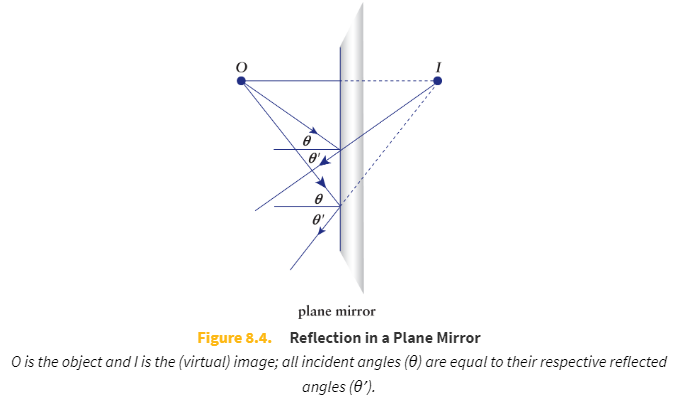
virtual
-
How can you tell that a mirror produces a virtual image?
Because the reflected light remains in front of the mirror but the image appears behind the mirror (i.e. light does not actually pass through the image's location)
-
Spherical mirrors come in two varieties: _____ and _____.
concave and convex
-
Spherical mirror
A spherical mirror can be considered a spherical cap or dome taken from a much larger spherically shaped mirror.
-
Concave
Having an outline or surface that curves inward like the interior of a circle or sphere. If we were to look from the inside of a sphere to its surface, we would see a concave surface.
-
Convex
Having an outline or surface curved like the exterior of a circle or sphere. If we were to look from outside the sphere, we would see a convex surface.
-
Concave mirrors are called _____ and convex mirrors are called _____.
converging mirrors
diverging mirrors
-
MNEMONIC: Concave is like looking _____.
into a cave
-
Parallel incident light rays to a concave mirror _____.
converge
-
Parallel incident light rays to a convex mirror _____.
diverge
-
Focal length
The focal length (f) is the distance between the focal point (F) and the mirror.
-
Equation for focal length of a spherical mirror

radius of curvature (r) is the distance between C and the mirror
-
Relationship between key variables in geometric optics

f is focal length
o is the distance between the object and the mirror
i is the distance between the image and the mirror
r is the radius of curvature
While it is not important which units of distance are used in this equation, it is important that all values used have the same units as each other.
-
Center of curvature
The center of curvature (C) would be the center of the spherically shaped mirror if it were a complete sphere.
-
Radius of curvature
The radius of curvature (r) distance between the center of curvature and the mirror.
-
Key variables in geometric optics (diagram)
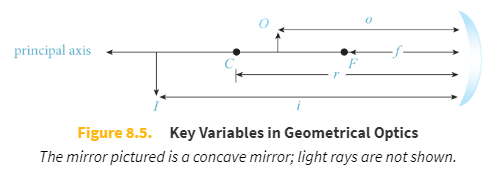
-
Image distance
The distance between the image and the mirror
-
If the image has a _____, it is a real image, which implies that the image is _____ the mirror.
positive distance (i > 0)
in front of
-
If the image has a _____, it is virtual and thus located _____ the mirror.
negative distance (i < 0)
behind
-
Plane mirrors can be thought of as _____.
What is the consequence of this?
spherical mirrors with infinitely large focal distances
As such, for a plane mirror, r = f = ∞, and the equation becomes 1/o + 1/i = 0, or i = –o.
-
For a plane mirror, the virtual image is ...
... at a distance behind the mirror equal to the distance the object is in front of the mirror.
-
Magnification equation

-
The magnification gives the ratio of ...
... the size of the image to the size of the object.
-
Magnification
The magnification (m) is a dimensionless value that is the ratio of the image distance to the object distance.
-
A negative magnification signifies an _____ image.
inverted
-
A positive magnification signifies an _____ image.
upright
-
If |m| < 1, the image is _____ than the object.
smaller (reduced)
-
If |m| > 1, the image is _____ than the object.
larger (enlarged)
-
If |m| = 1, the image is _____ the object.
the same size as
-
Ray diagram
A ray diagram is a diagram that traces the path that light takes in order for a person to view a point on the image of an object.
-
For a concave mirror, a ray that strikes the mirror parallel to the axis is reflected back _____.
through the focal point
-
Axis of a mirror
The normal passing through the center of the mirror
-
For a concave mirror, a ray that passes through the focal point before reaching the mirror is reflected back _____.
parallel to the axis
-
For a concave mirror, a ray that strikes the mirror at the point of intersection with the axis is reflected back _____.
with the same angle measured from the normal
-
Any time an object is at the focal point of a converging mirror or lens, the reflected rays will be _____, and thus, the image will be _____.
parallel
at infinity
-
When an object is placed at a distance f away from a convergent mirror or lens, the image is _____.
at infinity/nonexistent
-
When an object is placed at a distance 2f away from a convergent mirror or lens, the image is _____.
real, inverted, and the same size as the object
-
When an object is placed at a distance >2f away from a convergent mirror or lens, the image is _____.
real, inverted, and reduced
-
When an object is placed at a distance between 2f and f away from a convergent mirror or lens, the image is _____.
real, inverted, and enlarged
-
When an object is placed at a distance <f away from a convergent mirror or lens, the image is _____.
virtual, upright, and enlarged
-
When an object is placed in front of a diverging mirror or lens, the image is _____.
virtual, upright, and reduced regardless of the distance to the mirror
-
When an object is placed in front of a plane mirror, the image is _____.
virtual, upright, and the same size as the object regardless of the distance to the mirror.
-
The focal length of converging mirrors will always be _____. The focal length of diverging mirrors will always be _____.
positive
negative
-
MNEMONIC: UV NO IR
Upright images are always virtual
No image is formed when the object is a focal length away
Inverted images are always real
-
Inverted images are always _____.
real
-
Upright images are always _____.
virtual
-
Mirror: When o is positive, ...
... the object is in front of the mirror.
-
Mirror: When o is negative, ...
... the object is behind the mirror.
Note: this situation is rarely tested on the MCAT
-
Mirror: When i is positive, ...
... the image is real.
-
Mirror: When i is negative, ...
... the image is virtual.
-
Mirror: When r is positive, ...
... the mirror is concave (converging).
-
Mirror: When r is negative, ...
... the mirror is convex (diverging).
-
Mirror: When f is positive, ...
... the mirror is concave (converging).
-
Mirror: When f is negative, ...
... the mirror is convex (diverging).
-
Mirror: When m is positive, ...
... the image is upright (and virtual).
-
Mirror: When m is negative, ...
... the image is inverted (and real)
-
Mirror: When |m| > 1, ...
... the image is enlarged.
-
Mirror: When |m| < 1, ...
... the image is reduced.
-
Mirror: When |m| = 1, ...
... the image is the same size as the object.
-
For a concave mirror, a ray that is incident to the center of the mirror will _____.
be reflected back at same angle relative to normal.
-
Refraction
Refraction is the bending of light as it passes from one medium to another and changes speed.
-
The speed of light through any medium is always _____.
less than its speed through a vacuum
-
Index of refraction equation

c is the speed of light in a vacuum
ν is the speed of light in the medium
n is a dimensionless quantity called the index of refraction of the medium
-
The index of refraction of a vacuum is _____, by definition.
1
-
For all materials, the index of refraction will be _____.
greater than 1
-
For air, n is essentially _____.
equal to 1
-
The index of refraction of water is _____.
~1.33
-
Snell’s law
n1 sin θ1 = n2 sin θ2
n1 and θ1 refer to the medium from which the light is coming
n2 and θ2 refer to the medium into which the light is entering
Note that θ is measured with respect to the normal
-
When light enters a medium with a higher index of refraction (n2 > n1), it bends _____.
toward the normal
-
When light enters a medium with a smaller index of refraction (n2 < n1), the light will bend _____.
away from the normal
-
Critical angle
When light enters a medium with a smaller index of refraction, light bends away from the normal. As the incident angle is increased, the refracted angle also increases, and eventually, a special incident angle called the critical angle (θc) is reached, for which the refracted angle θ2 equals 90 degrees.
-
Critical angle equation

-
Total internal reflection
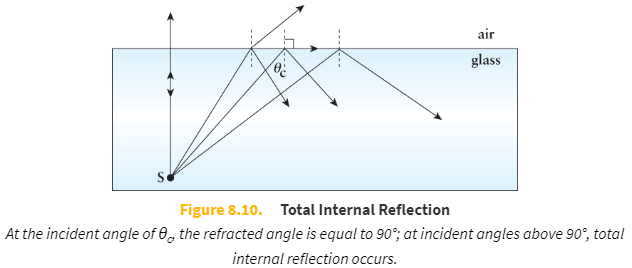
A phenomenon in which all the light incident on a boundary is reflected back into the original material and results from any angle of incidence greater than the critical angle, θc
-
Total internal reflection can only occur as the light moves from a medium with a _____ refractive index to a medium with a _____ one.
higher -> lower
-
When working with lenses, there are _____ that affect the light path.
two surfaces
-
On the MCAT, lenses generally have _____.
negligible thickness
-
Because light can travel from either side of a lens, a lens has _____.
two focal points
-
For thin spherical lenses, the focal lengths are _____.
equal
-
Relation between focal length, object distance, and image distance for lenses

-
Magnification of lenses

-
Lensmaker’s equation

n is the index of refraction of the lens material
r1 is the radius of curvature of the first lens surface
r2 is the radius of curvature of the second lens surface
-
A converging lens is always _____ at the center.
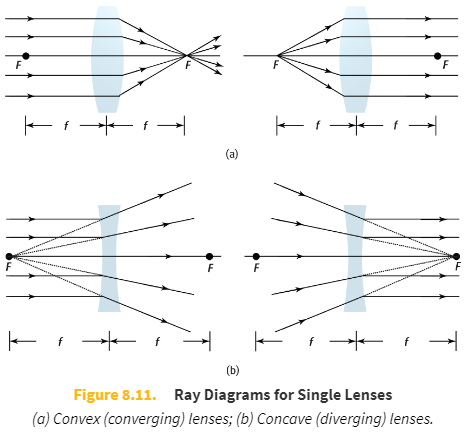
thicker
-
A diverging lens is always _____ at the center.
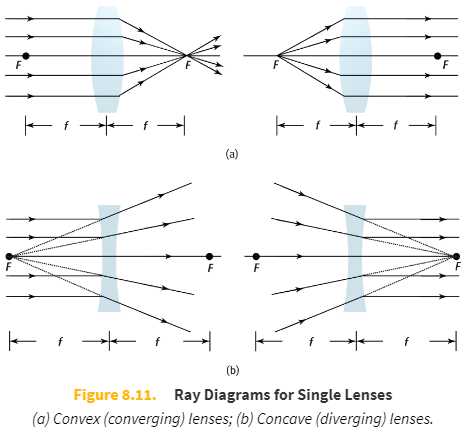
thinner
-
Lensmaker’s equation (use)
For lenses where the thickness cannot be neglected, the focal length is related to the curvature of the lens surfaces and the index of refraction of the lens by the lensmaker’s equation.
-
Diverging lenses are _____.
concave
-
Converging lenses are _____.
convex
-
What are the "lenses" of the eye?
The cornea acts as the primary source of refractive power because the change in refractive index from air is so significant.
Then, light is passed through an adaptive lens (the lens) that can change its focal length before reaching the vitreous humor.
It is further diffused through layers of retinal tissue to reach the rods and cones. At this stage, the image has been focused and minimized significantly, but is still relatively blurry. Our nervous system processes the remaining errors to provide a crisp view of the world.
-
A ray entering a lens parallel to the axis refracts _____.
through focal point of front face of the lens
-
A ray entering a lens through or toward the focal point before reaching the lens refracts _____.
parallel to the axis
-
A ray entering through the center of a lens ...
... continues straight through with no refraction.
-
Lens: A positive o means ...
Object is on same side of lens as light source

